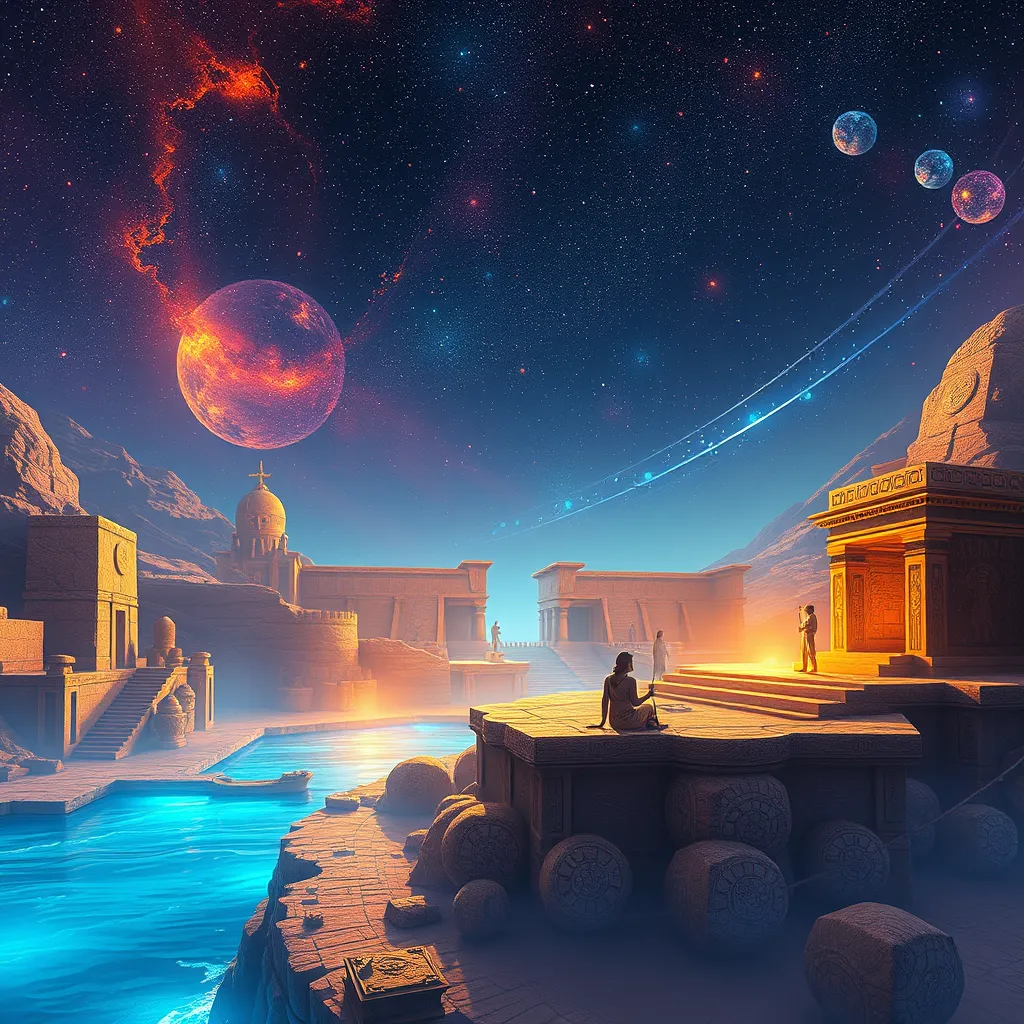The Duat: A Realm of Hidden Wonders
I. Introduction to the Duat
The Duat, often referred to as the Egyptian underworld, holds a pivotal place in ancient Egyptian mythology. It is a complex realm that serves as the afterlife destination for souls post-mortem. The significance of the Duat extends beyond mere geography; it represents the spiritual journey and the trials faced by the deceased as they navigate the afterlife.
As one explores the wonders within the Duat, it is essential to recognize its role in the belief systems of ancient Egyptians. The Duat was not only a place of judgment and rebirth but also a rich tapestry of landscapes filled with deities and mythical creatures, each contributing to the soul’s journey towards eternal life.
II. The Structure of the Duat
The Duat is characterized by its diverse landscapes and environments, making it a fascinating realm to explore. The geography of the Duat varies from serene fields to terrifying landscapes, symbolizing the duality of life and death.
- Fields of Aalu: Known as the paradise of the afterlife, the Fields of Aalu are depicted as lush, fertile landscapes where souls can enjoy eternal bliss.
- The Lake of Fire: A contrasting environment, the Lake of Fire represents punishment and purification for souls deemed unworthy, where they face their sins.
- Other Regions: The Duat contains various other regions such as the Hall of Judgment, where souls are weighed against the feather of Ma’at, and the realm of Serqet, the scorpion goddess who protects against evil.
Each of these locations carries profound symbolic meanings, reflecting the beliefs of ancient Egyptians about morality, judgment, and the afterlife experience.
III. The Inhabitants of the Duat
The Duat is teeming with a myriad of inhabitants, each playing a crucial role in the afterlife narrative. Among the most significant are the deities associated with this mystical realm.
- Osiris: The God of the Afterlife, Osiris, presides over the Duat, guiding souls and overseeing the judgment process.
- Anubis: The jackal-headed god of mummification and the afterlife, Anubis is responsible for protecting graves and guiding souls through the Duat.
Additionally, the Duat is populated by the spirits of the deceased and various creatures, such as the fearsome Ammit, who devours the souls of the unworthy. Guardians within the realm, like the forty-two assessors, help determine the fate of each soul during their journey.
IV. The Journey Through the Duat
The journey through the Duat begins immediately after death, where the soul embarks on a perilous path filled with trials and tribulations. This journey is not just a physical passage but a spiritual odyssey that tests the worthiness of the soul.
One of the most significant challenges faced by souls is the judgment of the heart, where the heart of the deceased is weighed against the feather of Ma’at, symbolizing truth and justice. This act determines whether the soul can proceed to the Fields of Aalu or faces punishment.
The Book of the Dead, a collection of spells and prayers, serves as a guide for souls navigating the Duat. It provides instructions and protections for the deceased in their quest for eternal life.
V. Symbolism and Art in the Duat
Artistic representations of the Duat are found in ancient texts and artifacts, showcasing the rich iconography associated with this realm. Hieroglyphics play a crucial role in illustrating the stories and beliefs surrounding the Duat.
- Hieroglyphics: These ancient writings not only depict deities and landscapes but also convey the narratives of the deceased’s journey through the Duat.
- Artifacts: Items such as tomb paintings, funerary objects, and the famous Book of the Dead highlight the importance of the Duat in ancient Egyptian culture.
The myths and stories associated with the Duat, such as the tale of the sun god Ra’s nightly journey through the underworld, further elucidate the significance of this hidden realm in understanding life, death, and rebirth.
VI. The Duat in Modern Culture
The influence of the Duat extends into contemporary culture, where its themes and symbols resonate in various forms of literature and media. The concept of an afterlife filled with trials and deities has inspired many modern narratives.
- Literature: Several authors have drawn upon the imagery of the Duat to explore themes of death and the afterlife.
- Film and Video Games: The Duat has been represented in movies and video games, often as a mysterious and perilous realm that characters must traverse.
- Spiritual Practices: Modern spiritual and esoteric practices occasionally reference the Duat, using its symbolism to discuss themes of transformation and spiritual rebirth.
VII. The Duat and Its Connection to Other Mythologies
When comparing the Duat to other mythologies, one can observe shared themes and concepts regarding the afterlife. For instance:
- Greek Hades: Similar to the Duat, Hades represents a realm where souls reside after death, with its own set of challenges and judgments.
- Norse Hel: The Norse concept of Hel also encompasses a form of afterlife where souls are judged and assigned to different realms.
These comparisons reveal universal themes of judgment, rebirth, and the exploration of hidden realms that transcend individual cultures, emphasizing the human fascination with what lies beyond death.
VIII. Conclusion
In summary, the Duat stands as a realm of hidden wonders, embodying the complexities of ancient Egyptian beliefs about the afterlife. Its landscapes, inhabitants, and the journey of the soul offer profound insights into the nature of existence and the human condition.
The enduring legacy of the Duat in the human imagination encourages us to delve into ancient myths, fostering a deeper understanding of life, death, and the spiritual journey that every soul undertakes.




